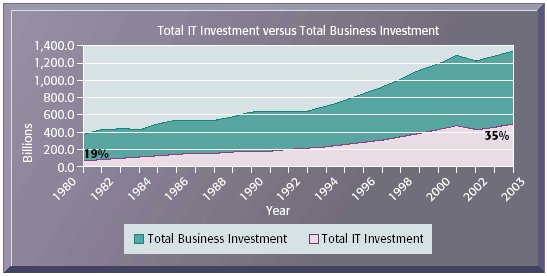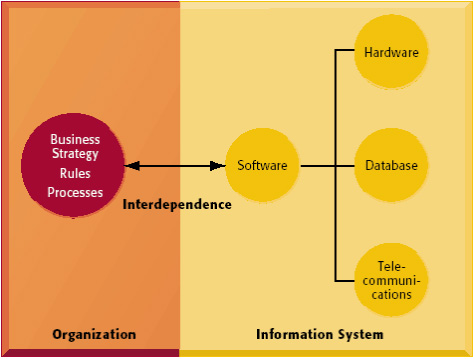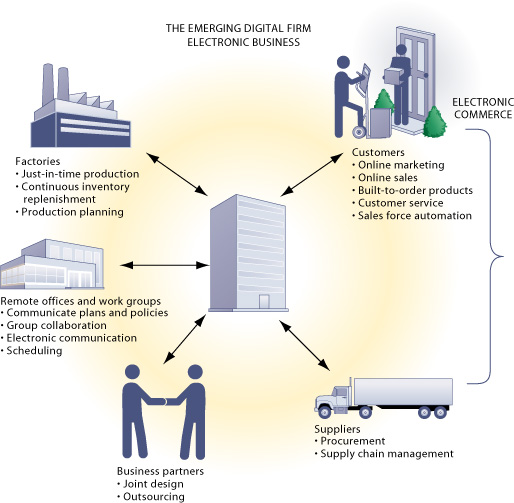| Section 1.1: Bullet Text | Chapter
Contents | View
Full Text |View Bullet Text |
Why Information Systems?
Information
technology and systems have revolutionized
firms and industries, and have become the largest component of capital
investment in the U.S. and many industrialized societies. Investment in
information technology accounts for more than one-third of all capital
invested in the United States. [Figure 1-1]

|
|
FIGURE 1-1 Information technology capital
investment |
Information
systems are the foundation of doing business for e-commerce and many industries
such as finance, insurance, real estate, travel, medicine, and education.
The ability of a firm to use IT is becoming intertwined with the firm’s
ability to implement corporate strategy.
IT
is one of the more important tools, along with related innovations in
organization and management, for achieving strong gains in productivity. [Figure 1-2]
 |
FIGURE 1-2 The interdependence between organizations and information systems In contemporary systems, there is a growing interdependence between a firm’s information systems and its business capabilities. Changes in strategy, rules, and business processes increasingly require changes in hardware, software, databases, and telecommunications. Often, what the organization would like to do depends on what its systems will permit it to do. |
IT investments are very often essential for realizing new business opportunities and competitive strategies.
There is considerable variation in firms’ ability to use IT effectively. IT strategies that are successful for one firm may not be successful for another.
Successful IT investment must be accompanied by significant changes in business operations and processes as well as changes in management culture and behavior.
Five factors illustrate the growing impact of IT in business firms today and over the next ten years.
-
The Internet and Technology Convergence: The merging of telephone networks into the Internet and growth of Internet-connected devices illustrate the breakdown of traditional boundaries and growth of new markets and business relationships. Firm’s relationships with business partners and clients are becoming digital relationships. Digital networks have enabled electronic business (e-business), electronic commerce (e-commerce), and e-government.
- Transformation of the Business Enterprise: The Internet
and new markets are changing traditional revenue structures and business
models. Firms are no longer limited by traditional organizational
boundaries or physical locations. Information technology has provided
the opportunity for organizations to become flattened (less hierarchical)
and decentralized with flexible arrangements of generalists who rely
on real time information to deliver mass-customized products and services
uniquely suited to specific markets or customers.
- Globalization: Information systems provide the communication
and analytic power that firms need to conduct trade, manage businesses
on a global scale, and become competitive in international markets.
- Rise of the Information Economy: The U.S. and other
major industrial powers are transforming from industrial economies
to knowledge- and information-based service economies, while manufacturing
is moving to lower-wage countries. Knowledge and information work
account for 60 percent of the US GNP and nearly 55 percent of the
labor force. [Figure 1-3]

FIGURE 1-3 The growth of the information economy
Since the beginning of the twentieth century, the United States has experienced a steady decline in the number of farm workers and blue-collar workers who are employed in factories. At the same time, the country is experiencing a rise in the number of white-collar workers who produce economic value using knowledge and information.
Source: U.S. Department of Commerce, Bureau of the Census, Statistical Abstract of the United States, 2003, Table 615; and Historical Statistics of the United States, Colonial Times to 1970, Vol. 1, Series D, pp. 182–232..
- Emergence of the Digital Firm: A digital firm is one where nearly all significant
relationships with customers, suppliers, and employees, as well as
key corporate assets, are digitally enabled and mediated. Core business
processes are accomplished thorough digital networks
spanning the entire enterprise or linking multiple organizations.
Business processes are the unique ways in which organizations coordinate
and organize work activities, information, and knowledge to produce
a product or service. Filling an order is an example of a business
process. Digital firms are able to respond more rapidly, operate with
more flexibility, and achieve greater levels of efficiency, profitability,
and competitiveness. [Figure 1-4]

FIGURE 1-4 Electronic business and electronic commerce in the emerging digital firm
Companies can use Internet technology for e-commerce transactions with customers and suppliers for managing internal business processes, and for coordinating with suppliers and other business partners. E-business includes e-commerce as well the management and coordination of the enterprise.
|
|